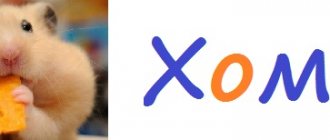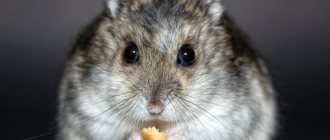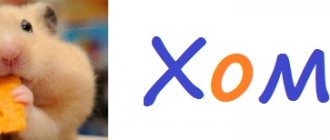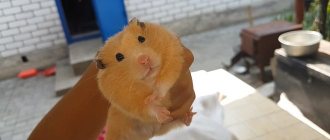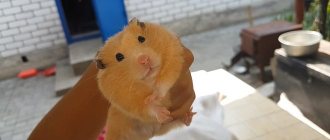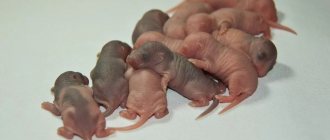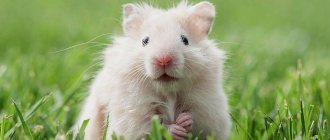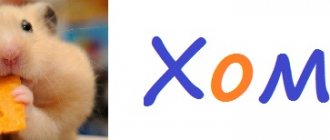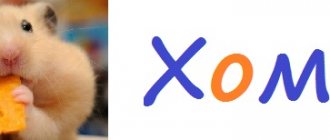- home
- General information
11/01/2018 Distinguishing dzhungarik from Campbell is not an easy task. These two popular varieties of dwarf hamsters are similar in appearance, which is why they are confused by inexperienced sellers in pet stores, misleading buyers. When purchasing a hamster, it is extremely important to know its breed correctly. This is directly related to the character of the pet, the characteristics of taming and caring for it, its health and proper nutrition. Despite all their similarities, the Dzhungarik and the Campbell have characteristic features that will help to recognize that the animal belongs to a specific breed.
Djungarian hamster and Campbell's hamster: biological characteristics
Both of these rodents represent the genus of hairy hamsters. The ability of individuals of both species to mate with each other has led to the emergence of hybrids, which are often found in pet stores.
Both the dwarf and Campbell's hamster are small in size - 7–10 cm long. Adults weigh around 70 g. The animals' lifestyle is predominantly nocturnal.
The miniature size of these hamsters allows them to be kept in small cages, terrariums or aquariums. Individuals are placed in “houses” only one at a time. Wood shavings or sawdust are placed on the floor of the rodent's home. The basis of the diet of hamsters of both breeds is:
- grain mixtures;
- pumpkin seeds;
- dried corn cobs.
In nature, these rodents live in burrows with 4–5 “entrances and exits.” Each passage leads to a specific “room” - a “rest room”, “food block”, etc. Under natural conditions, the breeding season of animals occurs in the warm part of the year - from March to October. Hamsters living in captivity reproduce without reference to the seasons.
The female gives birth to up to 11 cubs per litter. The duration of pregnancy for Djungarians and Campbells is different: for the former it is 21–26 days, for the latter it is 18–22 days.
Recommendations for owners
Campbell's dwarf hamsters have very poor vision and perception of the world around them. Cataracts are also common in older hamsters. To compensate for this deficiency, they have many glands that are located on the face, on the cheeks, behind the ears and near the rectum.
Many owners notice that hamsters can clean and groom themselves in places that are unfamiliar to them. This is done so that their scent creates a trail that will allow them to find their way back to the hole. This behavior is possible for repeated visits to places with more food. Such scent trails can persist for up to eight days.
In addition to cataracts, hamsters can develop diabetes, glaucoma and tumors (both benign and malignant). Many benign and malignant tumors can be removed surgically.
How to distinguish a Djungarian hamster from a Campbell's hamster
At first glance, the Campbell's hamster and the Djungarian hamster look like twin brothers. But upon closer examination, the differences are striking. Representatives of both breeds have characteristic external features that distinguish one species from the other. These include:
- coat color;
- wool quality;
- carcass structure;
- eye color.
In addition to external signs, observing their behavior will help to distinguish individuals of these breeds. Rodents have different characters and temperaments, which, of course, affects their behavioral characteristics.
Conclusion
The above signs will help you easily distinguish between breeds. If the animal does not match the basic traits, this indicates crossbreeding, which is undesirable for these breeds, as it can cause mutations in subsequent generations. But crossing allows you to achieve unique, rather interesting shades of wool.
It is important to remember that, unfortunately, both breeds have a rather short life expectancy - only three years, but proper maintenance and care will give you a pet that will delight you and give you pleasant emotions.
Color
The coat color of both hamsters is not limited to one option. The colors of individuals of these breeds are varied and some are similar in shades. Based only on the color of the fur coat, it is problematic to distinguish one animal from another; this sign should be used in combination with others.
The color of dzhungarikas is predominantly dark brown. Individuals with gray and black coats are often found.
Campbell's fur has amber, golden, cream and sandy shades, sometimes brown. The color of these animals is characterized by reddishness.
When looking at an animal's fur coat, it is important to pay attention not so much to the color as to the dark pattern. According to this sign, hamsters cannot be confused. The Djungarian has a distinct and wide stripe on its back (especially in the withers area). A smooth line goes to the head of the rodent and forms a kind of diamond on the muzzle. In some individuals this stripe continues all the way to the nose.
Depending on the color of the dwarf, the described diamond can be bright and clear (in brown rodents), or it can be almost invisible against the main background (in gray individuals). Unlike the Djungarik, Campbell does not have a rhombus in the pattern. The line on the back is thin and almost invisible in the lower part of the body.
On the sides of both animals, between the back and belly, there is a pattern in the form of arched arcs. But if in Djungarians this pattern is clearly expressed, then in Campbells it is barely distinguishable against the background of the main color.
Main differences
Despite many similar features, the main differences are highlighted:
Wool
The Djungarian hamster has dense fur, it is quite smooth and shiny. Campbells have a wavy coat and appear a little shaggy in appearance.
Color
Campbell's main shades:
- orange (mandarin)
- pearl
- sapphire.
Often, hamsters are red in color, have a uniform color, and have a dark stripe on the back.
A rare shade found in this species is agouti; even more rare are albino, argent, opal, gray, blue, spotted. The fur is somewhat disheveled.
Djungarians can come in a wide variety of colors, but their distinctive feature is stripes on the sides, on the back and a diamond on the face. The coat lies tightly and smooth.
Another important point is that in the cold season, Campbells have a change in coat color, and the Djungarian hamster may have a change in the stripe on its back, completely matching the main shade.
Anatomical differences
Dzungariks have an oval carcass that looks like an oval. Campbells externally repeat the outline of the number 8, due to the presence of a waist. The Djungarian rodent never has red eyes, while others do, but quite rarely. The Djungarian hamster has larger ears than the Campbell's.
Behavior
Many people like Djungarian hamsters and often get them: thanks to their friendliness, they are easily tamed and easy to get along with.
Campbell's rodent, on the contrary, is aggressive, and it is almost impossible to tame it. Both breeds are quite active animals; they love to run in a wheel, bury themselves in sawdust and create order in the bowl, creating noise.
Character
Each individual has its own character. But, focusing on the majority of representatives of a particular variety, it is possible to determine the character inherent in the breed.
The Djungarian hamster is good-natured and friendly. It is easily tamed and, with proper training, becomes sociable. His behavior rarely shows aggression. A little affection and care - and the animal will happily fall asleep in the palms of its owner.
The Campbell's hamster is more unsociable and can be aggressive. It is fundamentally difficult to handle and can even bite. But with the right approach, the animal will become affectionate, kind and gentle. The main thing is to surround him with care and love and he will respond in kind.
There are also opposite individuals - unsociable Dzungarians and affectionate Campbells. As a rule, the character of an animal can be determined in a pet store by observing it for a few minutes before purchasing.
Peppermint treat
Ingredients:
- 1 medium overripe banana.
- 2 chicken eggs.
- 3 tbsp. spoons of honey.
- 3 tbsp. tablespoons of liquid coconut oil (can be replaced with sunflower oil in the same amount).
- 1/2 teaspoon mint flavoring.
- 1/2 teaspoon baking powder.
- A quarter cup of carob (roasted carob powder). A small amount of cocoa can be substituted, but this is not recommended for animals. Therefore, try to find an original product.
- Oat flour.
Cooking procedure.
1. Mash the banana in a bowl.
2. Beat eggs into the resulting mass, add honey, baking powder, cinnamon and coconut (sunflower) oil.
3. Add oatmeal to the mixture to form a firm but slightly moist dough.
4. Divide the resulting volume into 2 equal parts.
5. Pour 1/4 cup of carob powder into one half, and add the same amount of flour to the second half. A hard lump should form that does not stick to your hands.
6. Roll out 2 rectangles, 9-10 mm thick.
7. Place the layers of dough on top of each other and roll along the long side. Wrap the resulting sausage in plastic wrap and put it in the refrigerator overnight.
8. Preheat the oven to 180 degrees.
9. Cover a baking sheet with parchment paper.
10. Remove the film and cut into 3-3.5 cm rounds.
11. Place on a baking sheet. During cooking, portions of dough will not increase in volume, so you can place them close to each other.
12. Bake for 10-15 minutes.
If you want to please your pet with a crunchier treat, cut the rolls into thin slices (about 1 cm), and after cooking, additionally dry them in a warm oven or even in a non-stick frying pan.
The finished product is stored for a long time in a dry place. So, by baking peppermint rolls once, you can treat your four-legged pupil with them for a long time.
Bon appetit to your dog!
I like it I don't like it
Which hamster is best as a pet?
Hamsters of both breeds sleep during the day, and rustle at night (with food in a bowl, a running wheel, sawdust in the bedding, etc.). You can watch them for hours. Like any hamster, their life is short - 2-3 years.
A comparison of characters makes the dzhungarik more suitable for the role of a pet - sweet, kind, easily tamed. Campbell is more capricious, but he can also be subdued. Care plus delicious treats - and the ice in the rodent’s heart will melt. For those who are not afraid of the educational process (and bites), the obstinate Campbell is also suitable.
It is important to remember that a particular individual may have the opposite character. Before purchasing, it is worth observing the selected individual.
Interesting facts about golden hamsters
Animals of this breed living in captivity are very friendly and not at all aggressive. This is what distinguishes them from their wild counterparts. But at the same time, they skillfully guard their territory and will not allow strangers to be on it. For them there is no concept of family ties. These animals prefer to live alone and are capable of killing a weaker hamster. Therefore, owners should keep them alone.
Scientists have proven that Syrian hamsters can eat almost anything. Therefore, in addition to seeds and grains or fruits, they also need to eat animal protein. In the wild, they can eat insects, carrion, or even hunt other small animals. In addition, sometimes females can destroy their offspring, which their owners try to prevent in captivity.
At home, these animals should be given lean and thoroughly cooked poultry or fish. Otherwise, these small and usually calm animals become quite aggressive and can bite.
Djungarian hamsters
The Djungarian hamster is another famous domestic representative of the hamster family. It is characterized by a height of up to 10 centimeters and a weight of 35–65 grams. They are characterized by fur-covered feet, as well as a recognizable dark (usually gray) stripe on the back. These animals have almost no tail.
Their fur is very beautiful due to the presence of white hairs. Despite the fact that now small animals of this species are considered to be domestic, they can sometimes be found in the wild in semi-deserts or dry steppes, for example, in Khakassia, in the south of Western Siberia and in the Dzungarian Alatau. Hamsters usually live 2-3 years, but can sometimes live up to four years.
Interesting things about hamsters
Mankind first learned about the Djungarian hamster in 1773, thanks to an entertaining and fairly reliable description of the famous traveler and scientist Peter Simon Pallas. He saw this animal during his trip through the territories of what is now Kazakhstan. Even at that time it had an almost modern appearance. And the hamster’s habits have hardly undergone any changes since that time.
In winter, hamsters of this species do not sleep. They can actively move even in the snow and search for food in it.
During shedding, animals' fur may change color. This usually occurs at temperatures below sixteen degrees Celsius for a long time.
They have fluffy gray fur with a recognizable gray stripe. At the same time, in winter it noticeably brightens, becoming silver.
In the Altai Territory you can often find these small furry animals even at an altitude of up to 3000 above sea level.
Djungarian hamsters live in slightly branching burrows. Their homes have a number of holes and chambers.
They prefer to be extremely active at night and in the evening. At the same time, rodents sleep during the day.
In severe frosts, as well as when there is a lack of oxygen or stress, these animals can fall into a peculiar state of torpor, which scientists call torpor. At the same time, their body temperature can drop by as much as 20 degrees. This phenomenon was first described in laboratory conditions, but it also occurs in the wild.
Hamsters of this breed live for approximately 2.5 years, but in good conditions they can live longer.
Rodents of this species are popular among many pet lovers from all over the world. Therefore, you can find them almost everywhere. Such animals do not require special knowledge or serious care from their owners. Their content is simple and cheap. Food, cages and toys for hamsters are inexpensive and always available at any pet store. At the same time, you can easily do a lot of things to maintain them with your own hands.
Djungarian hamsters, like most representatives of other breeds of hamsters, are cheerful and inquisitive. And even a small child can handle their contents. If desired, such animals can be trained and taught simple tricks. They are believed to lift a person's mood and relieve stress. But at the same time, parents who want to get a hamster for their child should remember that the life of such an animal is short-lived. Therefore, his death can become a real tragedy for a child or a very impressionable person.
Features of behavior in the wild
Representatives of this breed are settlers of steppes and semi-deserts. In their natural habitat, they dig small burrows with several entrances, usually to a shallow depth. The basis of the diet consists of plant seeds and their green parts. By the way, hamsters’ homes have special compartments for storing supplies.
Interesting fact: representatives of this breed do not hibernate. Animals have learned to regulate their body temperature. Their night life is very varied, so they have to be especially active, due to which their body temperature rises to 40 degrees. Long before sunrise, the animals go to take a nap. Sleep helps the hamster's body cool down to 20 degrees. It is this lifestyle that helps you rationally spend your energy and save energy.
Campbell's hamsters do not live long. in the wild – about two years. At home, animals can live twice as long.
Rodent health
The list of diseases is extensive. The owner’s main task is to detect symptoms in time and immediately contact a specialist (ratologist).
Signs that your hamster is sick:
- cloudy, watery eyes, discharge from them;
- decreased activity;
- wet fur around the tail or on the belly;
- hair loss, scratching, wounds;
- weight loss;
- loud breathing, sneezing;
- nasal discharge;
- bowel dysfunction;
- refusal to eat.
The presence of at least one of the signs may indicate the development of a serious disease.
In most cases, Campbell's hamsters suffer from:
- Proliferative ileitis. A severe and contagious infectious disease.
- Diarrhea. The reason is improper feeding or infection.
- Conjunctivitis. Appears due to eye injuries (ingress of bedding particles into them) and non-compliance with maintenance conditions.
- Lymphocytic choriomeningitis. Contagious viral infection. Transmitted to humans.
- Diabetes. Characterized by increased thirst and frequent urination. There is no treatment. Temporary treatment includes diet and insulin injections.
- Polycystic disease. There is no treatment. Symptoms: the belly is swollen, the hamster constantly lies down and does not clean itself.
- Eczema. Allergy to material or filler.
Older individuals may develop tumors. Treated with surgery.
Campbells are stubborn and can fight until there is blood and death.
Summarizing
Sometimes the individuals encountered do not fit into the characteristic parameters of the breeds. These are hybrids that arose as a result of crossing animals of different breeds. If during the selection process you like such a “mixed” representative, you should not refuse to purchase just because of its origin. These rodents take the best traits from their parents - both in appearance and in character. The only negative is that procreation is not recommended at all, i.e. a half-breed pet should not have offspring. Reproduction of these individuals is almost impossible - with rare exceptions, the born cubs are not viable.
Breed diseases
Campbells are susceptible to various infectious diseases. It is rare that a hamster has never had a cold in its life. It is not recommended to treat the animal yourself. At the first signs of illness, it is best to take your animal to the veterinarian. In addition to colds, hamsters often suffer from tumors. To get rid of these unfortunate creatures, you just need to get rid of chips, crackers and other similar products. Rodents are also prone to polycystic disease (infertility) and diabetes - melon, watermelon and other sweet fruits are not allowed.
You can give a small amount of melon and watermelon seeds. They are full of good things.
Body type
The Djungarian hamster and the Campbell breed have the same dimensions. Their body length does not exceed 10 cm. Accordingly, they belong to dwarf rodents. Smaller than them is only the Roborovsky hamster, whose body length does not exceed 6 cm.
If you look closely at the physique of miniature rodents, it has some differences. Campbell's hamster boasts a waist. Accordingly, if you look at the rodent from top to bottom, the body structure will resemble the figure 8. The Dzungarian dwarf rodent has a more rounded shape. When viewed from above, the shape of its body can be compared to an egg.
